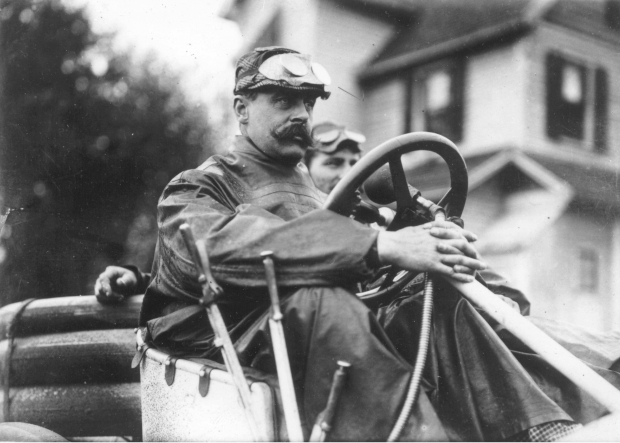Driver Profile: George Heath- The First Vanderbilt Cup Race Winner

Born on Long Island, New York in 1862 George Heath became an American living in Paris during the 1890’s. Drawn by the lure of France’s blossoming automobile industry he soon secured a job at the Panhard & Levassor factory. He first appeared as a driver of one of the company’s race cars in 1898, finishing 13th in the grueling, 889-mile Paris to Amsterdam to Pau Race.
The following year, in 1899, Heath demonstrated promise with a fourth place finish in the Paris to St. Malo Race, and a sixth at an auto race called the Tour de France. Aside from another sixth-place finish at Belgium’s Circuit Des Ardennes in 1902, Heath enjoyed little success until the greatest year of his driving career in 1904. That year he scored two major victories, the first at Circuit Des Ardennes and what proved to be the crowning achievement of his career, a win at the inaugural Vanderbilt Cup Race in his native Long Island, New York.
The First International Race for the William K. Vanderbilt, Jr. Cup held on October 8, 1904 boiled down to a good old-fashioned shoot-out of two men on opposite ends of their careers. The seasoned veteran, George Heath, a 42-year-old American expatriate, found himself pitted against a driver half his age in the form of Albert Clement Jr., driving a Clement-Bayard from his father's company.
Heath drove one of three Panhard entries in the 284.44 mile, 5 hour, 26 minute and 15 second ordeal over torturous terrain. The strongest of all teams, the Panhards led all but two laps of the race as teammate George Teste grabbed the top spot at the start, cut the race’s fastest lap (70.9 miles per hour) and maintained his advantage for the first three laps.
In contrast, Heath chose a measured strategy instead of constantly pressing his finely tuned French machine to its limits. Early on, he battled with Edward Hawley in a Mercedes before working his way into position to inherit the lead when Teste’s clutch failed on lap 4. Heath held this position until he suffered his second tire failure on lap 8 allowing Albert Clement in a Clement-Bayard to take the lead. The 21-year-old Frenchman gained further advantage when Heath was mistakenly told he was still leading when, in fact, he was not.Thinking he was leading, Heath “nursed” his car to mitigate any chance of further problems. It was not until Heath reached the Hicksville control on the ninth lap did he realize he was trailing.
The final two laps were the stuff of any great auto race from any era. Heath, in the faster car, knew he had to make up time and the only way to do so was to drive as fast as possible and to avoid a breakdown. Clement’s job was to drive just as hard as he could to keep the faster car at bay. While there was a burst of applause as Heath crossed the finish line at about 1:18 p.m., 5 hours, 26 minutes and 15 seconds after his pre-dawn start, the full force of excitement was reserved for the decisive appearance of Clement. It all boiled down to simple arithmetic. Clement started 10 minutes behind Heath, and to win he needed to arrive sometime within that margin.
Everyone at Westbury craned their heads in the direction of Queens listening for the first inkling of the smoking Clement-Bayard car. Just 1 minute, 28 seconds behind Heath’s total elapsed net time, Clement crossed the start-finish line, a tick past 1:29 in the afternoon. It was the closest finish in international road racing history up to that time. After winning Heath reflected on his driving skills:
“My control of my machine is instinctive. I know at all times just what speed I am making. Constant practice enables me to do these things. I like to travel fast, and I like to handle my car at great speed.”
As shown in this classic sports film, George Heath had earned his place in history.
Heath returned to Long Island in 1905, and again the Vanderbilt Cup Race and Circuit Des Ardennes were the high points of his season. He finished second at the Vanderbilt Cup Race driving the #14 Panhard and fifth in the Belgian contest.
After 1905, Heath’s racing career was in decline, his most notable accomplishment was a sixth place finish in the first French Grand Prix on an intensely hot day where several drivers quit due to eye irritation from chemicals in the steaming hot tar that coated a portion of the course. That race, staged in 1906, was the first auto racing Grand Prix held anywhere in the world. Heath returned to run the 1908 French Grand Prix and managed an eighth place finish. His career wound down from there ending the following year in 1909. Throughout his racing years he never drove any race car other than a Panhard.
Not much is known about the rest of Heath’s life, except that he returned to America just prior to the fall of France to Germany in World War II. New York’s Catskill Mountains provided the backdrop for Heath’s final home in what writer John Leathers described as a “hermit-like existence” in an October 1950 article published in The Bulb Horn. Heath died in obscurity during the 1940’s before the article was published.
Feedback and contributions are much appreciated on VanderbiltCupRaces.com . Please leave your comments at the end of a post on the Blog or send an email to me at [email protected] .











Comments
Interesting that he was born on L. I. I always just assumed that he was French! Thanks for the history lesson! Regards, Walter